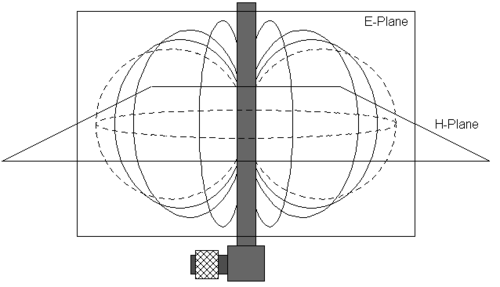E-plane and H-plane
The E-plane and H-plane are reference planes for linearly polarized waveguides, antennas and other microwave devices.
E-Plane
For a linearly-polarized antenna, this is the plane containing the electric field vector (sometimes called the E aperture) and the direction of maximum radiation. The electric field or "E" plane determines the polarization or orientation of the radio wave. For a vertically polarized antenna, the E-plane usually coincides with the vertical/elevation plane. For a horizontally polarized antenna, the E-Plane usually coincides with the horizontal/azimuth plane. E- plane and H-plane should be 90 degrees apart.
H-plane
In the case of the same linearly polarized antenna, this is the plane containing the magnetic field vector (sometimes called the H aperture) and the direction of maximum radiation. The magnetizing field or "H" plane lies at a right angle to the "E" plane. For a vertically polarized antenna, the H-plane usually coincides with the horizontal/azimuth plane. For a horizontally polarized antenna, the H-plane usually coincides with the vertical/elevation plane.


Co-Pol and Cross-Pol Directions
Co-polarization(Co-pol) on cross-polarization (X-pol) are defined for the radiating E and H planes. These directions are defined in spherical coordinates to correspond to the spherical wavefronts of the propagating wave. By convention the co-pol direction is the direction of the E field while the cross pol direction is the direction of the H field. Receive power for an co-pol oriented antenna is maximum while receive power is minimum for cross-pol orientation.